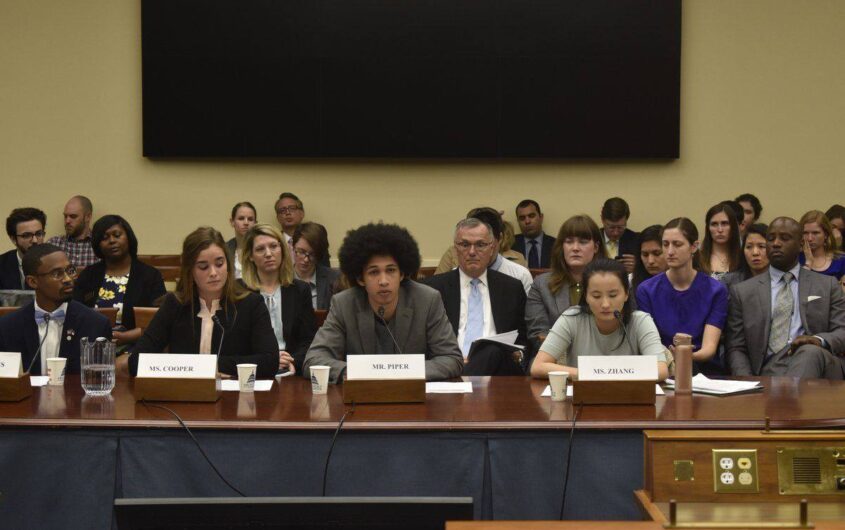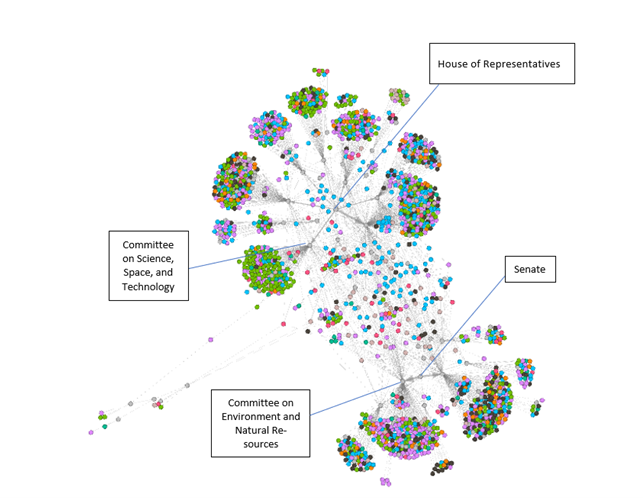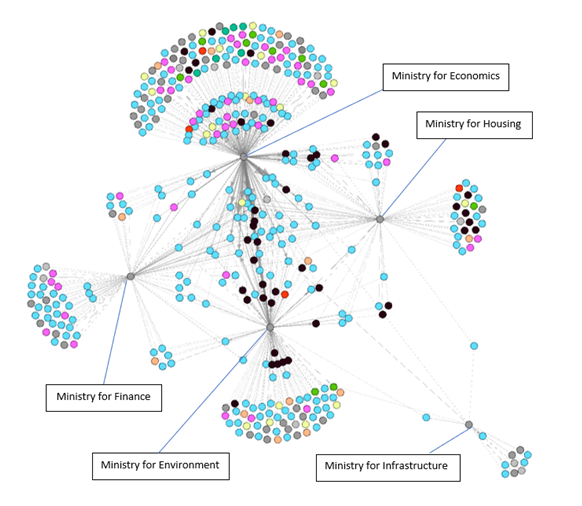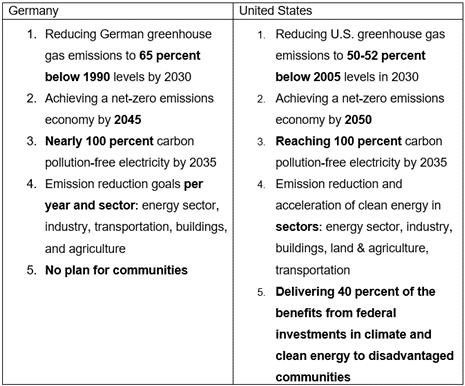
U.S. House Select Committee on the Climate Crisis via Facebook
Climate Policies in Germany and the United States

Daniel Rasch
FernUniversität Hagen
Daniel Rasch is a researcher in public policy and public administration with a focus on policy areas such as energy, environment, and security. He was an interim professor at the University of Public Administration in Speyer for Empirical Research Methods and is currently employed at the FernUniversität Hagen.
His PhD (2016) focused on framing and lobbying success in the multi-level governance context of the European Union. He published widely on the topic of governance and interest mediation.
His current research focuses on interest mediation in the German federal ministries. He investigates networks and power distribution within policy areas and within the federal administration and uses a vast array of methods, ranging from qualitative and quantitative text analysis, text reuse approaches, to network analysis.
During his time at AGI, he will be comparing German and U.S. climate policies and how they came to be after the Paris Agreement in 2015. Combing a network analysis and interviews, the comparison between Germany and the United States will shed light on
1) networks in climate policies, their characteristics, roles, and effects on decision-making,
2) the power distribution of involved stakeholders and decision-makers, and
3) the advocacy success of stakeholders in three instances of public policy.
Lobbying through Networks?
At the UN Climate Change Conference (COP 28) at the end of November 2023, big questions arose about how the states performed after the Paris Agreement (COP 21), the latest binding international treaty on climate change. Germany and the United States both ratified the Paris Agreement in December 2015. Whereas Germany has been “fully committed” since then, the Trump administration in the United States (2017-2021) had no intentions to create climate policies that “disadvantage the United States.” During the Trump presidency, the United States opted out of the Paris Agreement, effective in November 2020. President Biden, Trump’s successor, opted in again in February 2021.
Due to these disparate levels of commitment, are there distinctions in U.S. and German climate policies? If there are, what factors contributed to their development and shaped their current form?
Is giving evidence to policymakers lobbying?
Since policymaking is not straightforward and decision-makers act in an environment of incomplete information, evidence from external actors is needed. So-called consultations—used in different forms such as hearings or written consultations—are therefore a common and frequently-used procedure in the legislative process. Consultations serve as problem-solving patterns: when policymakers need information on specific policies or policy ideas that they cannot generate themselves, they resort to external actors. This information ranges from political support to shortcomings of proposed policies or even what to put on an agenda.
Such consultations can be defined as “inside lobbying”: stakeholders are part of a network with decision-makers and are asked to give their opinion on a policy idea, specific policy proposal, or bill. Their influence on the legislative process should not be underestimated. Studies analyzing legislative change and the influence of interest groups consistently show that the earlier organized interests of any kind intervene, the greater the effect and opportunity to change the resulting law.[1]
Various theories complement each other in explaining consultations and the use of external evidence during the decision-making process: On the one hand, from the perspective of democratic theories, they increase the input legitimacy of policies. Affected actors can contribute to policymaking and thereby alleviate the deficits of representative democracy. This way, political and administrative action is more legitimate and accepted due to the incorporation of those affected by the decisions.[2] On the other hand, as an exchange theory perspective would emphasize, influence resources, such as expert knowledge or political support, are exchanged for control over the decisions, which occurs particularly in consultations due to the direct contact between decision-makers and societal actors. This also increases output legitimacy through the higher quality and therefore acceptance of results.
In short: external actors and their positions regarding a policy proposal are valued in these consultations, and they increase the overall legitimacy of political decisions—if conducted within the limits of lobbying regulations.
Consultations happen in various formats, such as expert commissions, expert councils, or, related to specific policy proposals, often through written consultations or hearings. In the process, networks are established, defined as a mesh of relationships between individual and collective actors, such as interest groups, companies, or think tanks. Decision-makers know whom to contact and question. Networks in both countries can be characterized in different ways: some networks include more actors (different sizes) with very similar or very different stakeholders (different diversities), and some are very hierarchical whereas others are rather centralistic (varied structures).
Networks in German and U.S. Climate Policies after 2016
Policymaking in Germany and the United States is different due to their institutional setting. In Germany, most legislation is introduced by the government, not the parliament. The ministries prepare bills, which are then discussed, changed, and decided on by the German parliament. In the United States, the Congress is the center of legislative decision-making. Lobbyists that aim to influence decision-making therefore need access at the earliest point of entry. The following passages compare social networks of relationships between organized interests and the consulting ministries (German context) or Congressional committees (United States).
Figure 1 shows the networks of 577 instances of policymaking in the United States regarding climate policies since 2016.[3] There are 1,794 stakeholders active—each node represents one of these actors giving a statement in hearings. In general, the dominating actors are companies (22.64 percent, pink), individual experts (21.33 percent, green), and interest organizations (19.45 percent, blue). Out of the latter, 36 percent represent business interests and 33 percent public interests.
The figure shows that most stakeholders appear only one time in one of the committees of Congress, hence they are grouped together in big bubbles at the same distance to the committee. If there are smaller bubbles of actors closer to the committees (grey), it shows that these stakeholders have been invited more often than others. Examples of these front runners are the Department of Energy as a governmental actor, the Union of Concerned Scientists as an interest group, and the company ClearView Energy Partners, LLC.
It also shows that in Senate committees, we see a higher proportion of company representatives (pink) than in the House committees, especially in the Committee on Environment and Natural Resources.
Further, interest organizations (blue) of different kinds (business interests as well as public interest) are fairly distributed among the two chambers. We also see that there are many scientific experts (green), such as professors, lawyers, or doctors not connected to any specific lobbying group who are giving evidence on climate policies, especially in the House Committee on Science, Space, and Technology.
Subnational actors, such as state, county, or municipal representatives (black) make up close to 13 percent of all stakeholders. In addition, the share of local government actors (red) is quite high (circa 5 percent). This shows the significance and importance of state, regional, and local level actors for consultations in climate policies in the United States.
Figure 1: Network in U.S. climate policies since 2016

Source: own compilation. 1,794 nodes, 2,216 edges. Network graph created with Gephi. Expansion Scale factor 1.2 and ForceAtlas 2 with scaling 2.0 and gravity 1.0. To browse the network and see enhanced visualization: https://con-networks.com/project-networks-in-climate-policies/datenvisualisierung-usa
The German networks are based on only forty-six instances of policymaking since 2016 and consist of 426 stakeholders. Dominating actors are interest organizations (60.37 percent, blue), companies (11.44 percent, pink), and regional government actors (11.44 percent, black).
We see a clear dominance of interest groups (blue), both business and public interests, and only a few academic and professional experts (green). The latter only makes up about 2.5 percent of all stakeholders.
The role of local government and disadvantaged communities seem to have a better lobby in the United States than in Germany.
Most actors are connected to the Ministry for Economic Affairs and Climate Action. Again, the closer the actors are to the center, the more interconnected they are with other stakeholders, and the closer they are to the ministry, the more often they have been invited to consultations. Front runners in Germany are the Federal Association of the Energy and Water Industry (Bundesverband der Energie- und Wasserwirtschaft e.V.) as an interest group, the state-owned company Deutsche Energie-Agentur GmbH, and the Environmental Action Germany (Deutsche Umwelthilfe) as an NGO.
State and regional level actors (black) are of a certain importance (11 percent), but local stakeholders (red) are rarely present (one percent).
Figure 2: Networks in German climate policies since 2016

Source: own compilation. 426 nodes, 604 edges. Network graph created with Gephi. Expansion Scale factor 1.2 and ForceAtlas 2 with scaling 2.0 and gravity 1.0. To browse the network and see enhanced visualization: https://con-networks.com/project-networks-in-climate-policies/datenvisualisierung-deu/
There are three takeaways: first, the networks in U.S. policymaking are by far more diverse and interconnected than the German ones. This can likely be attributed to variations in institutional processes, contrasting a pluralistic system like the United States with a more neo-corporatist system like Germany. The neo-corporatist structure in Germany leads to a limited number of peak-level interest organizations with monopolies of interest representation in their sector and even an obligation to join these peak-level organizations in certain sectors. The stakeholders in the United States are far more diverse than German stakeholders, where we find a clear peak-level interest mediation structure and representation monopoly by these peak-level stakeholders. Out of these, 79 percent represent business interests and only 11 percent public interests.
Comparing the representatives of federal, state, regional, and local level stakeholders, we see that in both countries, the share of these stakeholders is nearly equal (11.44 percent in Germany and 13.69 percent in the United States). However, if we look closer, local actors (representatives of municipalities) are far less active in the German context, which refers to the institutional setting: in Germany, as an example of integrated federalism, territorial governments are linked in cooperative networks of joint decision-making, whereas in systems of divided federalism (United States), local governments tend to compete for funds or policy success. Here, especially local actors tend to be far more active.[4]
Third, policymaking of climate policies is done in thirty different committees across Congress, whereas only five ministries cover the interdisciplinary approach to climate change in Germany. This might reflect the high conflict in the United States but also covers additional sectors that are not dealt with in German ministries: Native American affairs and the connection between climate change and the U.S. Armed Forces. We find several bills or policy ideas that refer to the resiliency of U.S. Armed Forces facilities.
What are the external actors consulted about?
As pointed out above, there is a huge discrepancy in the number of policy proposals in Germany and the United States. In Germany, there is less than a tenth of policy ideas or proposals discussed compared to the United States in the same time frame (577 to 46). But looking more closely into the content of these proposals, Figure 3 shows that hearings in the U.S. Congress are mostly used for examination, oversight, and information-gathering purposes—at most soft measures. In addition, these soft measures include awareness building, information campaigns, or the collection of information. Germany mostly discussed regulatory instruments including specific measures for combating energy inefficiency, performance standards, or mandatory targets. Since Germany is also implementing a new emission trading system, we even find market-based instruments. Famous examples of the newest and most promising policies to tackle climate change in the United States are—according to the Biden White House—the Inflation Reduction Act and Bipartisan Infrastructure Law. In Germany, the Bundesklimaschutzgesetz (Climate Change Act 2021) sets the goals for climate policies, among others.
Figure 3: Share of types of policies under discussion in hearings and consultations

Source: own compilation according to Schaffrin et al. (2015) [5] = regulatory instruments include specific measures of combating energy inefficiency, performance standards, or mandatory targets; public investment policies refer to direct investment through programs, infrastructure investments, and RD&D; framework policies refer to processes undertaken to develop and implement policies, including specific programs; market-based instruments include tax incentives, subsidies to stimulate certain activities, behaviors, or investments; soft measures include education, outreach, awareness, information campaigns, voluntary agreements.
Next to specific policies (Figure 3), both countries set commitments. As summarized and compared in Table 1, Germany’s plan for greenhouse gas emission reduction is calculated along the 1990 emission levels and is more ambitious, whereas the U.S. plan uses the 2005 emission levels, which were higher.[6] The United States plans to achieve net-zero emission by 2050, whereas Germany plans to do this already by 2045. In electricity production, the U.S. plan is more ambitious, aiming to reach 100 percent carbon pollution-free electricity by 2035. Here, Germany’s cutoff of nuclear power plants in April 2023 might explain the rather cautious aim of nearly carbon pollution-free electricity production by 2050, having a long way to go with renewable energy only. Another difference can be found regarding the emission reduction aims per sector: only Germany sets the reduction goals yearly, whereas the U.S. plan contains a “long-term strategy” with goals for 2050. Lastly, President Biden’s plan covers disadvantaged communities—an area that does not seem to be covered by the German federal plan.
Table 1: Commitments presented on government web pages

Own compilation according to DEU1, DEU2, USA3, USA4.
Causal relation between policy content and networks?
Lobbying through networks does not automatically guarantee influence on decisions. However, we see certain patterns in access to decision-makers and that some are more often consulted than others. This access gives them a better opportunity to persuade policymakers or at least present their positions.
Comparing the climate policies in Germany and the United States, we can cautiously point to three aspects: First, consultations are used for different purposes in these countries. The higher diversity of organized interests in the United States reflects its pluralism, but in reference to the policy types, we also see that most policies are rather soft measures and only a few regulatory instruments. If German ministries consult, it is in direct connection to a drafted bill and most often on regulative instruments.
Second, the role of local government and disadvantaged communities seem to have a better lobby in the United States than in Germany. The fact that the German federal climate policies do not mention municipalities at all might be a result of its different system of federalism or a worse representation of local interests at the federal level. The dominance of companies (first place in the United States and second place in Germany) reflects the economic importance of climate policies. At the same time, 79 percent of the German interest organizations are business representatives. It is however necessary to dive into the positions of these companies themselves to see if they strive for strict or loose climate policies. In several publications, we can already see that there is no clear differentiation between economic interests and public interests, such as environmental protection.[7]
Third, the commitments presented in Table 1 do not differ by much: the aims of general greenhouse gas emission reduction are a little bit lower in the United States, but the plan to reach 100 percent of carbon pollution-free electricity by 2035 is more ambitious—probably because of a high degree of nuclear power production. Germany’s end of nuclear power usage will lead to more struggles and stronger efforts in renewable energy production to fill the gap.
It is important to mention that Germany’s climate policies are highly influenced by decisions at the European level. Many regulations, for example regarding wind power, force Germany to implement decisions where no consultations are needed or necessary. In addition, decision-makers might abstain from consultations since these take time to conduct. If time is scarce and decisions must be made quickly, for example for the Biden administration after taking office in 2021, policies might be made through an executive order, bypassing the decision-making process through Congress.
In the end, both countries will be measured according to their efforts and success in balancing climate policies along social acceptance, economic soundness, and, of course, effectiveness of environmental protection.
[1] Crepaz, M., Hanegraaff, M., & Junk, W. M., “Is There a First Mover Advantage in Lobbying? A Comparative Analysis of How the Timing of Mobilization Affects the Influence of Interest Groups in 10 Polities,” Comparative Political Studies 56, no. 4 (2023): 530-560. https://doi.org/10.1177/00104140221109441.
[2] Fink, Simon & Ruffing, Eva, “Legitimation durch Verwaltungsverfahren? Was sich die Politik von Konsultationen beim Stromnetzausbau verspricht,” dms – der moderne staat 8, no. 2 (2015): 253-271.
[3] Data collection: U.S. data on climate policies from 2016 onwards are retrieved from govinfo.gov. After searching for hearings with keywords, the hits were downloaded to an Excel file, with the help of a web scraping tool. The second step involved the coding of stakeholders and the policies with an existing coding scheme to enable comparison with the German data. The German data was collected from a German project on consultation processes (see https://con-networks.com/project-networks-in-climate-policies/). The German data was collected by hand since the reformed parliamentary register of the German parliament does not include references to where the stakeholders were active and/or gave evidence. They needed to be selected from the individual webpages of involved parliamentary committees and ministries. Once these steps were completed, the sociomatrix and adjacency matrix were created to enable the network analyses and visualizations.
[4] Hueglin, T., and A. Fenna, Comparative Federalism, 2nd ed. (Toronto: University of Toronto Press, 2015): p. 38; and Kincaid, J., “From dual to coercive federalism in American intergovernmental relations,” In Globalization and decentralization: Institutional contexts, policy issues, and intergovernmental relations in Japan and the United States, ed. J. S. Jun and D. S. Wright (Washington, DC: Georgetown University Press, 1996): 29-46.
[5] Schaffrin, A., Sewerin, S., Seubert, S., “Toward a Comparative Measure of Climate Policy Output,” Policy Studies Journal 43, no. 2 (2015): 257-282.
[6] According to https://ourworldindata.org/grapher/co-emissions-per-capita?tab=chart&time=1949..latest&country=USA~DEU, the 1990 and 2005 level of per capita CO2 emissions in the United States is very similar: 20.6 tons in 1990 to 20.7 tons in 2005.
[7] Gründinger, W., Lobbyismus im Klimaschutz. Die nationale Ausgestaltung des europäischen Emissionshandelsystems (Wiesbaden: VS Verlag für Sozialwissenschaften, 2012).
Supported by the DAAD with funds from the Federal Foreign Office (FF).









